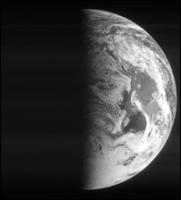







|
News and Information
Rosetta comet probe pictures home
| March 8, 2005 |

Rosetta pictures the earth (Esa)
Rosetta will make two more passes of the Earth
The European spacecraft Rosetta has pictured both the Earth and the Moon.
The probe swung by its home planet on Friday to help build up speed as it gets ready to sweep out towards Jupiter and meet up with a comet in 2014.
The Earth flyby - the first of three in the coming years - allowed scientists and engineers the opportunity to test Rosetta's systems and instruments.
The images demonstrate the spacecraft's good health as it continues its trek to Comet 67P/Churyumov-Gerasimenko.
Rosetta's closest approach occurred at 2209 GMT, when it was passing above the Pacific Ocean just west of Mexico at an altitude of 1,954km and moving at a relative speed of 38,000km/h.
Rosetta path (BBC)
A number of amateur and professional astronomers even managed to catch the three-tonne probe zipping across their detectors (see internet links).
The spacecraft is now heading for Mars, where it will swing by at an even shorter distance of just 200km on 26 February 2007.
Rosetta then returns for a further two passes of Earth - in November 2007 and 2009 - before beginning the long journey out to Jupiter's orbit.
The fly-bys are necessary to accelerate the spacecraft so as to eventually match the velocity of the target comet.
They are a fuel-saving way to boost speed using planetary gravity.
Once in orbit around the 4km-wide Churyumov-Gerasimenko, the £600m craft will despatch a small lander called Philae to the surface to study the object's chemistry.
Rosetta pictures the Moon (Esa)
The Moon was used to check object-tracking systems
The mission will follow Churyumov-Gerasimenko as it moves into the Sun, monitoring the changes that take place on the comet.
Comets - giant "dirty snowballs", as some have called them - are believed to contain materials that have remained largely unchanged since the formation of the Solar System 4.6bn years ago, and Rosetta data should help researchers understand better how our local space environment has evolved over that time.
Rosetta next task will be to assist the US space agency's (Nasa) Deep Impact mission, which will crash a projectile into Comet Tempel 1 on 4 July.
The European probe will observe the event from distance, collecting data using its ultraviolet light instrument called Alice, which can analyse the gases streaming off a comet. |
Source: www.bbc.com |
| http://news.bbc.co.uk/2/hi/science/nature/4328995.stm |
|
| Support Caprivi Freedom |
Fill out the form below to become a member of this site and receive our regular newsletter.
|

|

